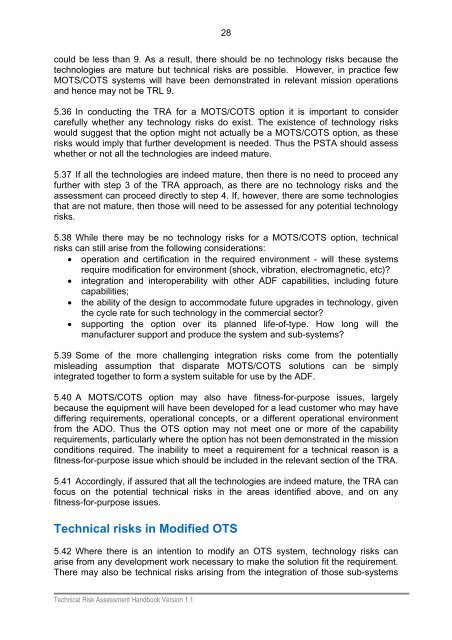Technical Risk Assessment Handbook - Defence Science and ...
Technical Risk Assessment Handbook - Defence Science and ...
Technical Risk Assessment Handbook - Defence Science and ...
You also want an ePaper? Increase the reach of your titles
YUMPU automatically turns print PDFs into web optimized ePapers that Google loves.
28<br />
could be less than 9. As a result, there should be no technology risks because the<br />
technologies are mature but technical risks are possible. However, in practice few<br />
MOTS/COTS systems will have been demonstrated in relevant mission operations<br />
<strong>and</strong> hence may not be TRL 9.<br />
5.36 In conducting the TRA for a MOTS/COTS option it is important to consider<br />
carefully whether any technology risks do exist. The existence of technology risks<br />
would suggest that the option might not actually be a MOTS/COTS option, as these<br />
risks would imply that further development is needed. Thus the PSTA should assess<br />
whether or not all the technologies are indeed mature.<br />
5.37 If all the technologies are indeed mature, then there is no need to proceed any<br />
further with step 3 of the TRA approach, as there are no technology risks <strong>and</strong> the<br />
assessment can proceed directly to step 4. If, however, there are some technologies<br />
that are not mature, then those will need to be assessed for any potential technology<br />
risks.<br />
5.38 While there may be no technology risks for a MOTS/COTS option, technical<br />
risks can still arise from the following considerations:<br />
• operation <strong>and</strong> certification in the required environment - will these systems<br />
require modification for environment (shock, vibration, electromagnetic, etc)<br />
• integration <strong>and</strong> interoperability with other ADF capabilities, including future<br />
capabilities;<br />
• the ability of the design to accommodate future upgrades in technology, given<br />
the cycle rate for such technology in the commercial sector<br />
• supporting the option over its planned life-of-type. How long will the<br />
manufacturer support <strong>and</strong> produce the system <strong>and</strong> sub-systems<br />
5.39 Some of the more challenging integration risks come from the potentially<br />
misleading assumption that disparate MOTS/COTS solutions can be simply<br />
integrated together to form a system suitable for use by the ADF.<br />
5.40 A MOTS/COTS option may also have fitness-for-purpose issues, largely<br />
because the equipment will have been developed for a lead customer who may have<br />
differing requirements, operational concepts, or a different operational environment<br />
from the ADO. Thus the OTS option may not meet one or more of the capability<br />
requirements, particularly where the option has not been demonstrated in the mission<br />
conditions required. The inability to meet a requirement for a technical reason is a<br />
fitness-for-purpose issue which should be included in the relevant section of the TRA.<br />
5.41 Accordingly, if assured that all the technologies are indeed mature, the TRA can<br />
focus on the potential technical risks in the areas identified above, <strong>and</strong> on any<br />
fitness-for-purpose issues.<br />
<strong>Technical</strong> risks in Modified OTS<br />
5.42 Where there is an intention to modify an OTS system, technology risks can<br />
arise from any development work necessary to make the solution fit the requirement.<br />
There may also be technical risks arising from the integration of those sub-systems<br />
<strong>Technical</strong> <strong>Risk</strong> <strong>Assessment</strong> <strong>H<strong>and</strong>book</strong> Version 1.1

















